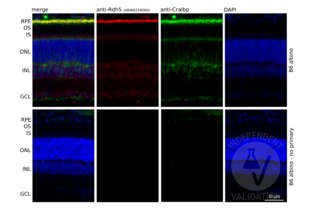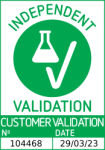RDH5 anticorps
-
- Antigène Voir toutes RDH5 Anticorps
- RDH5 (Retinol Dehydrogenase 5 (11-Cis/9-Cis) (RDH5))
-
Reactivité
- Humain, Souris
-
Hôte
- Lapin
-
Clonalité
- Polyclonal
-
Conjugué
- Cet anticorp RDH5 est non-conjugé
-
Application
- ELISA, Immunohistochemistry (IHC)
- Attributs du produit
- Polyclonal Antibody
- Purification
- Antigen affinity purification
- Immunogène
- Fusion protein of human RDH5
- Isotype
- IgG
-
-
- Indications d'application
- IHC 1:50-1:100, ELISA 1:5000-1:10000
- Restrictions
- For Research Use only
-
- by
- Palczewski Lab, Center For Translational Vision Research, UC Irvine
- No.
- #104468
- Date
- 23.03.2023
- Antigène
- RDH5
- Numéro du lot
- SG5433
- Application validée
- Immunohistochemistry
- Contrôle positif
Retina cryosection from B6 Albino (B6(Cg)-Tyrc-2J/J) animal
- Contrôle négative
Retina cryosection from B6 Albino (B6(Cg)-Tyrc-2J/J) animal
No primary antibody
- Conclusion
Passed. Presence of specific signal in the RPE cell layer was considered as indication of specific immunoreactivity using the anti-RDH5 antibody ABIN7254060.
- Anticorps primaire
- ABIN7254060
- Anticorps secondaire
- donkey anti-rabbit AF647-conjugated antibody (Abcam, 150075)
- Full Protocol
- Collect eyes from mice and fix with paraformaldehyde 4% (Electron Microscopy Sciences, 15710) in 1x PBS for 30 min at RT.
- Cryoprotection with sucrose series:
- Wash in 10% sucrose in 1x PBS.
- Immerse in 10% sucrose in 1x PBS for 30 min at RT.
- Wash in 20% sucrose in 1x PBS.
- Immerse in 20% sucrose in 1x PBS for 30 min RT.
- Wash in 30% sucrose in 1x PBS.
- 30% sucrose ON at 4°C.
- Embed eyes in OCT compound (Tissue-Tek O.C.T. Compound, 4583).
- Cut retinal sections at a thickness of 12 μm on a cryostat.
- Air dry sections for 15 min at RT, store at -80°C until use.
- Bring sections to RT and rehydrate in 1x PBS for 1 h.
- Incubate sections in blocking buffer (1x PBS, 3% BSA (Sigma-Aldrich, A7030), 3% Donkey serum (Sigma-Aldrich, S30-100ML), 0.1% Triton X-100 (Sigma-Aldrich, X100-500ML)) for 1 h at RT.
- Incubate sections with primary rabbit anti-RDH5 antibody (antibodies-online, ABIN7254060, lot SG5433) diluted 1:50 in blocking buffer ON at RT. Include a no primary antibody negative controls. Additionally, counterstaing with primary mouse anti-CRALBP antibody (Thermo Fisher Scientific, MA1-813).
- Rinse sections 3 times with 1x PBS, 0.1% Triton X100. Keep negative controls in a separate container.
- Incubate sections with secondary AF647-conjugated donkey anti-rabbit antibody (Abcam, Ab150075) or AF488-conjugated donkey anti-mouse antibody (Thermo Fisher Scientific, A32766) diluted 1:500 in blocking buffer for 1 h at RT.
- Rinse sections once with 1x PBS, 0.1% Triton X-100 for 5 min at RT.
- Incubate sections in 1x DAPI (Thermo Fisher Scientific, 62248) in 1x PBS, 0.1% Triton X-100 for 15 min at RT.
- Rinse sections 3x with 1x PBS, 0.1% Triton X-100 for 5 min at RT.
- Mount sections in VECTASHIELD® HardSet™ Antifade Mounting Medium (Vector Laboratories, H-1400) mounting medium.
- Acquire images with a fluorescence microscope and appropriate filter settings.For the validation purposes Keyence BZ-X800E fluorescence microscope was used with following filters: BZ-X DAPI for DAPI, BZ-X GFP for AF488, BZ-X Cy5 for AF647. Images were taken at 10x and 40x magnification.
- Notes
Experiment involved validation of the specificity of 4 antibodies against different Rdh proteins: Rdh5 (ABIN7254060), Rdh10 (ABIN7118460), Rdh11 (ABIN966957), and Rdh12 (ABIN7167836). All 4 proteins are important for eye function and highly expressed in neural retina and/or RPE. Validation is based on comparison of each staining with known pattern of expression in the mouse retina. For review highlighting each Rdh localization see PMID20801113.
To aid orientation in the cell layers anti-Cralbp counterstain was included in the staining (Thermo MA1-813). Cralbp (Rlbp1) is highly expressed in RPE and Müller glia cells in mouse retina.
Validation #104468 (Immunohistochemistry)![Testé avec succès 'Independent Validation' signe]()
![Testé avec succès 'Independent Validation' signe]() Validation Images
Validation Images![Retinal sections from the wild-type (B6 albino) mice immunostained with anti-RDH5 antibody ABIN7254060. DAPI staining shows localization of the inner (INL) and outer (ONL) nuclear layer of the mouse retina. Cralbp (Rlbp1) co-staining was used to visualize RPE and Müller glia cells in the retina. Presence of specific signal in the RPE cell layer confirms specific immunoreactivity.]() Retinal sections from the wild-type (B6 albino) mice immunostained with anti-RDH5 antibody ABIN7254060. DAPI staining shows localization of the inner (INL) and outer (ONL) nuclear layer of the mouse retina. Cralbp (Rlbp1) co-staining was used to visualize RPE and Müller glia cells in the retina. Presence of specific signal in the RPE cell layer confirms specific immunoreactivity.
Protocole
Retinal sections from the wild-type (B6 albino) mice immunostained with anti-RDH5 antibody ABIN7254060. DAPI staining shows localization of the inner (INL) and outer (ONL) nuclear layer of the mouse retina. Cralbp (Rlbp1) co-staining was used to visualize RPE and Müller glia cells in the retina. Presence of specific signal in the RPE cell layer confirms specific immunoreactivity.
Protocole -
- Format
- Liquid
- Concentration
- 0.84 mg/mL
- Buffer
- PBS with 0.05 % Sodium azide and 40 % Glycerol, pH 7.4
- Agent conservateur
- Sodium azide
- Précaution d'utilisation
- This product contains Sodium azide: a POISONOUS AND HAZARDOUS SUBSTANCE which should be handled by trained staff only.
- Stock
- -20 °C
- Stockage commentaire
- Store at -20°C. Avoid freeze / thaw cycles.
-
-
: "Rapid RGR-dependent visual pigment recycling is mediated by the RPE and specialized Müller glia." dans: Cell reports, Vol. 42, Issue 8, pp. 112982, (2023) (PubMed).
-
: "Rapid RGR-dependent visual pigment recycling is mediated by the RPE and specialized Müller glia." dans: Cell reports, Vol. 42, Issue 8, pp. 112982, (2023) (PubMed).
-
- Antigène
- RDH5 (Retinol Dehydrogenase 5 (11-Cis/9-Cis) (RDH5))
- Autre désignation
- RDH5 (RDH5 Produits)
- Synonymes
- anticorps 9cRDH, anticorps HSD17B9, anticorps RDH1, anticorps SDR9C5, anticorps RDHB, anticorps MGC84134, anticorps RDH5, anticorps rdh1, anticorps hsd17b9, anticorps im:6901729, anticorps si:dkey-102c8.5, anticorps 9-cis, anticorps AI987873, anticorps RDH4, anticorps cRDH, anticorps retinol dehydrogenase 5, anticorps retinol dehydrogenase 1, anticorps retinol dehydrogenase 5 L homeolog, anticorps retinol dehydrogenase 5 (11-cis/9-cis), anticorps RDH5, anticorps rdh1, anticorps rdh5.L, anticorps rdh5, anticorps Rdh5
- Sujet
- This gene encodes an enzyme belonging to the short-chain dehydrogenases/reductases (SDR) family. This retinol dehydrogenase functions to catalyze the final step in the biosynthesis of 11-cis retinaldehyde, which is the universal chromophore of visual pigments. Mutations in this gene cause autosomal recessive fundus albipunctatus, a rare form of night blindness that is characterized by a delay in the regeneration of cone and rod photopigments. Alternative splicing results in multiple transcript variants. Read-through transcription also exists between this gene and the neighboring upstream BLOC1S1 (biogenesis of lysosomal organelles complex-1, subunit 1) gene.
- UniProt
- Q92781
-


 (1 reference)
(1 reference) (1 validation)
(1 validation)



